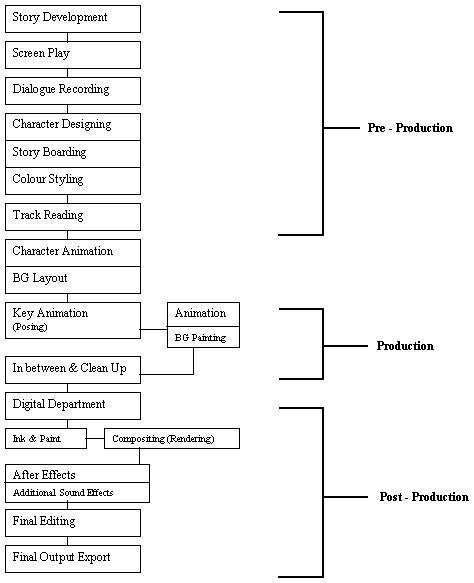

The background artist refers to the storyboard and draws the background for each scene. A background is a section or an angle of a location. The backgrounds are done directly out of the storyboard and location design. It also includes the character's main poses from the storyboard following the official design, and the effects, backgrounds and all the other information necessary to the animator. This folder contains a field guide that shows the proper camera move and the right size of the scene. The layout artist uses the storyboard and prepares an organized folder for the animator. The layout and posing process links the storyboard artist and the animator. For the small studio with a limited amount of resources, the storyboard artist or the animator creates the layout and posing.

The background layouts are done by one person or team and the posing by another. In both small and medium sized studios, background layout and posing is handled by the same person. The layout contains all the information needed to complete the animation in the scene: background, overlay, underlay, and key poses (usually referenced from the model pack). Background Layout and Posingįor a traditional production, the layout and posing step is very important to communicate the storyboard information very clearly to the animators. If the storyboard is done on paper, a person must be added to the team to scan the storyboard and prepare it for the animatic. Only one person is in charge of the animatic production to ensure consistency throughout the whole production. Before the animatic can be created, the storyboard must be completed, approved and locked. Each scene is timed along with sounds, dialogue and music. The animatic reel, or leica, is made from the storyboard. It can be started in parallel with the design and the audio recording, but some studios may wait until the designs and the audio recording are locked. The storyboard is the illustrated script of the film. It is important to minimize the revision to the visuals during the animation process. In this way, they can draw the correct facial and physical expressions to coincide with the dialogue. Nat pause is a generic audio read-through used by the storyboard artist to hear what the characters are saying and how it is said. This allows the animator to do the sound breakdown and animate the mouth and expressions, as well as the storyboard that's required. If there is dialogue involved in the project, the final version must be recorded soon enough to import it into the project before the animation. The voices are often recorded outside of the studio. The dialogue is also recorded from the script. If the backgrounds are painted in an external software, it is recommended that you do the locations (key backgrounds) colour styling in that same external software. It can be done on paper or directly in an animation software. It doesn't really have an impact on the pipeline. Colour StylingĬolour styling can be done before or after the animation. They are cleaned up, added to the model pack and sent to colour styling. For a traditional project, the designs can be done on paper or digitally. The design team will take charge of the character, prop and location design as soon as the script is locked. This process is similar to any other workflow. The storyboard artist will start working on the storyboard. This comes from either the studio itself or the client requesting the project.īy closely following the script, the design team will begin the character, props and locations and design. It is the foundation of the whole project.

The following descriptions will help you understand how the work is divided and give you a base to start building your own traditional pipeline. Everything in yellow and grey is done in the animation software.
#2d animation pipeline software#
The storyboard is typically done on paper, but scanned in using either specific software or animation software. In the following illustration, all the purple steps are done via software (like recording) or on paper (character designs, animation, backgrounds, etc). Many of the steps cannot be done simultaneously, meaning they must be completed before continuing on to the next step in the process. The traditional workflow is a very straight forward pipeline. Familiarize yourself with this simplified version and then move to the next graphic explaining in more details how the various steps connect. In a traditional workflow, many steps are done manually.


 0 kommentar(er)
0 kommentar(er)
